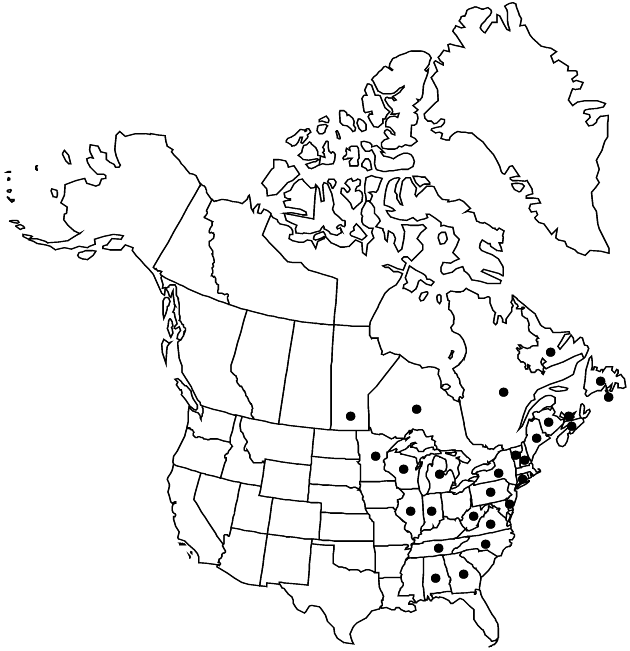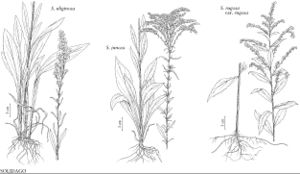Difference between revisions of "Solidago uliginosa"
J. Acad. Nat. Sci. Philadelphia 7: 101. 1834.
FNA>Volume Importer |
FNA>Volume Importer |
(No difference)
| |
Revision as of 18:42, 24 September 2019
Plants 30–120(–200) cm; rhizomes branched, elongate, thick. Stems usually 1, erect, glabrous, short hispido-strigose in arrays. Leaves: basal and proximal cauline tapering to long petioles that partially sheath stems; blades oblanceolate, 100–350 × 5–60 mm, margins subentire to serrate, apices acute; mid to distal sessile, not sheathing stems, blades lanceolate, 20–50 × 5–10 mm, much reduced distally, margins entire. Heads 35–230 in elongate paniculiform arrays, sometimes narrow and secund pyramidal, usually narrowly to broadly, non-secund thyrsiform; branches strongly ascending with non-secund heads to arching with heads secund. Peduncles 1–4 mm, glabrous or sparsely strigose. Involucres 3–5 mm. Phyllaries (14–18) in 3–5 series, unequal, usually apically ciliate; outer ovate, acute, inner linear-oblong, obtuse. Ray florets 1–8 (moderately conspicuous); laminae 3.2–3.7 × 0.4–0.6 mm. Disc florets 6–8; corollas 4.6–5 mm, lobes 0.6–1 mm. Cypselae 1–2 mm, glabrous or sparsely strigillose; pappi 2.7–3 mm (weakly clavate). 2n = 18, 36.
Phenology: Flowering Aug–Sep.
Habitat: Bogs and wet areas, marshes, sometimes in wet woods
Elevation: 0–1500+ m
Distribution

St. Pierre and Miquelon, Man., N.B., Nfld. and Labr., N.S., Ont., P.E.I., Que., Ala., Conn., Del., Ga., Ill., Ind., Maine, Mich., Minn., N.H., N.Y., N.C., Pa., Tenn., Vt., Va., W.Va., Wis.
Discussion
Solidago uliginosa is highly variable in stem height and the size of the array, which are greatly influenced by growing conditions. A. Cronquist (1980) treated S. simulans as a “broad-leaved extreme of S. gracillima, approaching S. uliginosa.” These plants come from a distinctive habitat in western North Carolina, south of more typical populations of S. uliginosa; it might warrant recognition as a narrowly distributed endemic. In the north, several different tetraploid races within the species appear to be derived separately from diploids in the eastern and the Great Lakes portion of the range.
Selected References
None.
